-

人教版高中历史必修2开辟新航路说课稿3篇
一、说教材《开辟新航路》是高中《历史·必修二》第5课的内容。从三个方面向学生介绍了欧洲人开辟新航路的历史:即新航路开辟的原因和条件、新航路开辟经过以及影响。前4课内容介绍了古代中国经济的基本结构与特点,从第5课开始学习资本主义世界市场的形成和发展。本课内容相当重要,上承古代中国,下启近代世界。新航路的开辟,打破了世界相对隔绝的状态,世界真正开始融合为一个整体。从此,以西欧为中心的世界市场的雏形开始出现。随后的殖民扩张,世界市场拓展;第一次工业革命,世界市场基本形成;第二次工业革命,世界市场发展。二、说目标1、课程标准概述迪亚士、哥伦布开辟新航路的史实,认识地理大发现对世界市场形成的意义。2、三维目标①知识与能力:掌握新航路开辟的原因、经过、影响。②过程与方法:引导学生分析原因及影响,培养学生分析和归纳问题的能力。③情感态度与价值观:A、通过对新航路开辟过程的学习,使学生感受和学习探险家们勇于进取的开拓精神。B、通过学习新航路开辟的影响,使学生认识新航路开辟促进了人类社会的整体发展。
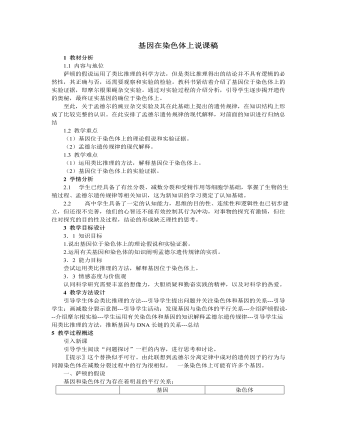
人教版高中生物必修2基因在染色体上说课稿
三、孟德尔遗传规律的现代解释①分离定律:在杂合体的细胞中,位于一对同源染色体上的等位基因,具有一定的独立性;在减数分裂形成配子的过程中,等位基因随同源染色体的分开而分离,独立地随配子遗传给后代。②自由组合定律:位于非同源染色体上的非等位基因的分离或组合是互不干扰的;在减数分裂过程中,同源染色体的等位基因彼此分离的同时,非同源染色体上的非等位基因自由组合。总结:再次强调孟德尔遗传定律的现代解释课堂练习:书本31页6、教学反思:本节课设置了一系列问题情境,层层设问,在学生答问、质疑、讨论过程中让学生建构新概念和新的知识体系,并通过教师及时掌握反馈信息,适时点拨、调节,让学生在推理判断中培养良好的思维习惯和对知识的迁移能力,而且通过留出一定的时间让学生提问,体现了以学生为主体的思想。
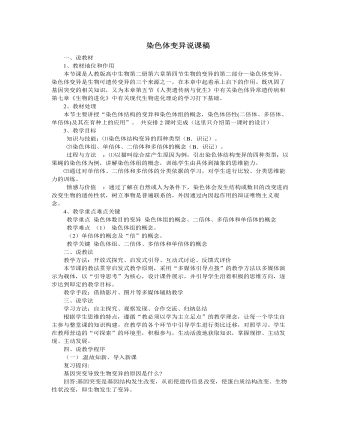
人教版高中生物必修2染色体变异说课稿
四、说教学程序(一).温故知新、导入新课复习提问:基因突变导致生物变异的原因是什么?回答:基因突变是基因结构发生改变,从而使遗传信息改变,使蛋白质结构改变、生物性状改变,即生物发生了变异。那么,基因是什么?它和染色体又有何关系?回答:基因是有遗传效应的DNA片断,染色体是DNA的载体,基因在染色体上呈线形排列。引出新知:对于一个生物体来说,正常情况下,其染色体的结构和数量都是稳定的。但在自然条件或人为因素的影响下,染色体的结构和数量均会发生改变,从而导致生物性状的改变,这就属于染色体变异。(二).把握重点、突破难点重点的把握:1、染色体结构的变异播放影片:猫叫综合征幼儿。让学生观察: 患儿哭声轻、音调高,很像猫叫。教师补充: 患儿的征状---两眼较低、耳位低下,存在着严重的智力障碍。阐述病因---染色体片段缺失
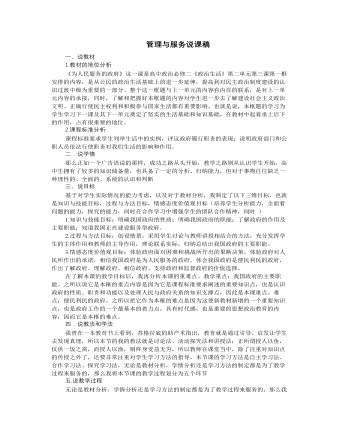
人教版高中政治必修2管理与服务说课稿
环节四 课堂小结 巩固知识本节课我采用线索性的板书,整个知识结构一目了然,为了充分发挥学生在课堂的主体地位,我将课堂小结交由学生完成,请学生根据课堂学习的内容,结合我的板书设计来进行小结,以此来帮助教师在第一时间掌握学生学习信息的反馈,同时培养学生归纳分析能力、概括能力。环节五 情景回归,情感升华我的实习指导老师告诉过我们,政治这一门学科要从生活中来到生活去,所以在课堂的最后布置了课外探究题,以此培养学生对理论的实际运用能力,同时检验他们对知识的真正掌握情况,以此达到情感的升华,本节课,我根据建构主义理论,强调学生是学习的中心,学生是知识意义的主动建构者,是信息加工的主体,要强调学生在课堂中的参与性、以及探究性,不仅让他们懂得知识,更让他们相信知识,并且将知识融入到实践当中去,最终达到知、情、意、行的统一。
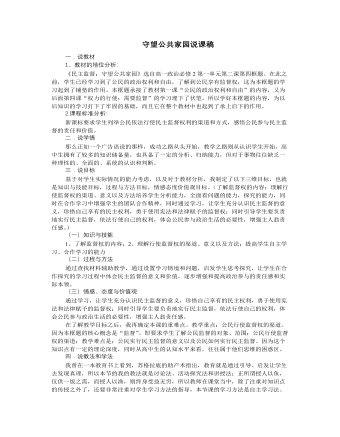
人教版高中政治必修2守望公共家园说课稿
环节四 课堂小结 巩固知识本节课我采用线索性的板书,整个知识结构一目了然,为了充分发挥学生在课堂的主体地位,我将课堂小结交由学生完成,请学生根据课堂学习的内容,结合我的板书设计来进行小结,以此来帮助教师在第一时间掌握学生学习信息的反馈,同时培养学生归纳分析能力、概括能力。环节五 情景回归,情感升华我的实习指导老师告诉过我们,政治这一门学科要从生活中来到生活去,所以在课堂的最后让学生考察自己所在社区存在的问题,然后制定监督方案,以此培养学生对理论的实际运用能力,同时检验他们对知识的真正掌握情况,以此达到情感的升华,本节课,我根据建构主义理论,强调学生是学习的中心,学生是知识意义的主动建构者,是信息加工的主体,要强调学生在课堂中的参与性、以及探究性,不仅让他们懂得知识,更让他们相信知识,并且将知识融入到实践当中去,最终达到知、情、意、行的统一。
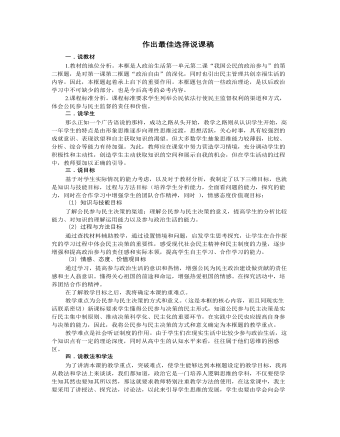
人教版高中政治必修2作出最佳选择说课稿
环节四 模拟演练 情感升华我将让同学们阅读课本22页的材料,并按照所提供的步骤,组织学生举办一次模拟听证会,将学生分为四个小组,分别扮演教育局工作人员、人大代表、学生家长、学校校长的角色。待学生们模拟听证会结束后,我将采访学生,让他们谈谈参加完听证会后的感受,从而利用角色感悟总结落实民主决策的重大意义。这样,学生们在模拟演练中,感悟公民要通过各种渠道参与民主决策,是推进决策科学化、民主化的重要环节。为学生将来参与政治生活积累经验,增强了学生的主人翁意识和社会责任感。环节五 课堂小结 课后延伸我将用多媒体展示本节课的知识框架,并注重引导学生将今天所学新知识与前面知识联系起来,帮助学生从宏观上把握各知识点之间的关系,有利于学生理解记忆。另外,适当的课堂练习能检验学生掌握知识的情况,因此,课堂小结后我将让学生做一些典型的练习,加深学生对本课知识的理解,同时为为下一课的学习做准备。
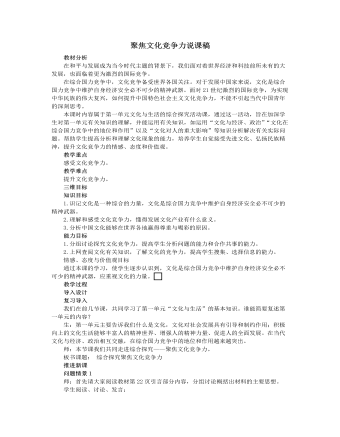
人教版高中政治必修3聚焦文化竞争力说课稿
(1)文化与经济、政治在经济基础上相互影响。①经济、政治和文化是社会生活的三个基本领域。其中,经济是基础,政治是经济的集中表现,文化是经济和政治的反映。一定的文化由一定的经济、政治所决定,又反作用于一定的政治、经济,给予政治、经济以重大影响。②经济发展是文化发展的基础。但这并不意味着文化的发展始终与经济的发展亦步亦趋。如同不能简单地把精神文明看作是物质文明的派生物和附属品一样,也不能简单地认为文化是经济、政治的派生物和附属品。文化有其自身的传承性和相对的独立性。那种认为只要物质条件好了,精神文化自然而然地就会好起来,物质条件差一点,精神文化就不可能搞好的观点,不符合历史发展的事实,是不正确的。③掀开历史的画卷,文化既有古今和地域之别,又有先进与落后、腐朽之分。不同的文化,对经济、政治的影响不同,对社会发展的作用也不同。不同民族的文化,影响不同民族和国家各具特色的发展道路。
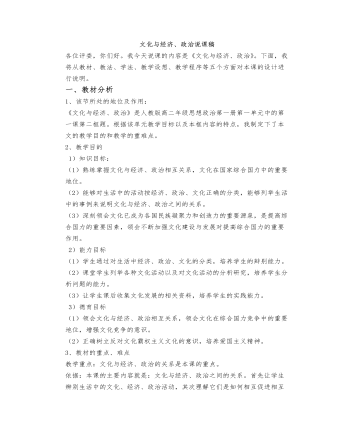
人教版高中政治必修3文化与经济、政治说课稿
(二)讲授新课:1、讲授重点:文化与经济、政治的关系。我首先带领学生分析课本上的活动探究,了解日常生活中的常见活动,让学生们观看视频材料帮助学生对文化活动、经济活动、政治活动进行辨别和分类。然后让学生们举例说明,综合探究,最后通过集体讨论得出文化与经济政治的关系:经济是基础,政治是经济的集中表现,文化是经济和政治的反映,一定的文化由一定的经济和政治决定,又反作用于政治和经济。这个问题是本课重点。要引导学生循序渐进,集体讨论,得出结论。2、突破难点:(1)文化与经济政治相互交融,在时代发展的进程中。首先播放上海世博会视频,让学生体会文化、经济、政治活动,另外我会引导学生积极举生活中的事例,来说明问题,让学生学会举一反三,充分理解这一知识,让学生明白文化与经济、政治的联系,让学生清楚文化渗透的力量有多大,帮助学生树立反对文化霸权主义的意识。
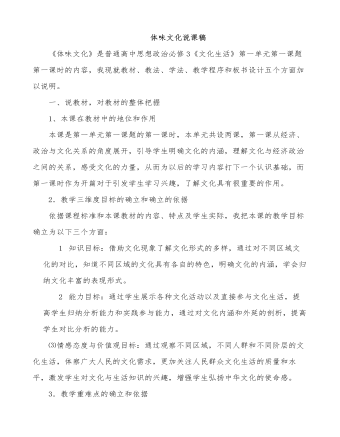
人教版高中政治必修3体味文化说课稿
(二)引入内容1、播放幻灯片,从名言引出思考,什么是文化,如何理解文化?学生探究,既可质疑,也可谈自己对文化的理解2、幻灯片,以三组幻灯,分三个阶段,学生分别通过小组讨论的形式,归纳总结文化现象的三个特征3、根据对文化现象的认识,归纳总结文化的内涵及外延小活动:把不是文化的山、水、树,由几组同学画出来,体会文化的含义4、一组判断题,哪些是文化的,哪些不是5、理解文化的特点首先,根据前面,总结文化现象的特征,归纳出文化的普通性及特殊性其次,播放视频,归纳总结文化是人类特有的现象第三,根据教材材料,小组探究总结,文化是后天习得的第四,借助小活动的材料,归纳,文化需要一定的物质载体6、文化的作用首先、观看视频,小组探究总结,文化对于人的影响其次,观看视频,小组探究总结,文化对社会的影响

人教版高中英语必修2Computers说课稿3篇
一. 教材分析1. 本单元的中心话题是“计算机(Computers)”,内容涉及计算机的发展历史,计算机的应用等。本节课是该单元的第一课时,我将Warming up, Pre-reading and Comprehending这四部分整合为一节精读课。其中。Reading部分是题为WHO AM I?的文章,以第一人称的拟人手法介绍了计算机发长演变的历史和计算机在各个领域的应用,其主旨是表达计算机的发展变化之快以及在生活中用途之广。而Warming up部分以图片的形式展现了计算机的发展历程;Pre-reading中的问题和排序分别是为了预测语篇的内容和测试学生对计算机历史了解的情况;Comprehending则通过各项练习训练学生的阅读技能,从而加深对文章的理解。可见这几部分是一个有机的整体。2. 教学目标:1) 语言目标:重点词汇及短语:abacus, calculate, calculator, PC, laptop, PDA, robot, analytical, technological, universal, mathematical, artificial, intelligent, network, explore, in common, as a result.重点句子:a. My real father was Alan Turing, who in 1963 wrote a book to describe how computers could be made to work, and build a “universal machine” to solve any mathematical problem.

人教版高中英语必修2Cultural Relics说课稿2篇
Ⅲ. Analysis of the teaching material:The topic of this unit is cultural relics. Students are quite interested in topics about different cultures around the world. This is the second period of the whole unit. As a reading class, the passage mainly talks about the history of the amber room (how it was made, sent as a gift, lost and rebuilt).According to the new national curriculum, when teaching reading, much emphasis should be put on training the students’ reading skills.Ⅳ. Teaching objectives1. Language objectives:1) Students are required to master the key words and phrases occurred in the passage (e.g. amazing, decorate, belong, in return, less than etc.)2) Students are required to learn the attributive clause and acquire the sentence pattern.2. 1) Students are required to describe a certain thing by using the new sentence patterns.2) Students are required to master two kinds of reading skills—skimming and scanning, and learn to use them in their daily reading.3. 1) Students are required to know the history of the amber room.2) Students are required to appreciate cultural relics and understand the importance of protecting them.Ⅴ. Teaching important and difficult points1) the new words, phrases, and sentence pattern in the course of reading.2) Teaching difficult point: Help the students master two kinds of reading skills—skimmingand scanning and learn to apply them in daily use.Ⅵ. Teaching methods:Task-based method & Top-down model Ⅶ. Teaching aids: PPT, pictures, blackboard Ⅷ. Teaching procedure:

人教版高中英语必修3Astronomy the science of the stars说课稿3篇
Step 2 Pre-listeningAfter students finish their discussion, I will show a picture of Newton and ask them: Who is him? What is he famous for? Could you find out some words to describe him? Maybe students will answer that he is genius for his finding of theGravitation, making a great contribution to the progress of human being. At that time I will show another two pictures of Einstein and Hawking, letting students guess who they are and write down their idea about the Gravitation. For I have arranged them to search more information about the gravity before this class, Students have beenfamiliar with the topic and will not be afraid about this abstract conception, which is helpful for their listening.Step 3 While-listeningIn this step, students will be required to listen the material for three times. The first and listening is extensive listening and the second and third listening is intensive listening. In the first time, They are required to listen a material including Part 1 and Part 2 and choose the best summary of the listening text. After they choose the right answer, They also need work in group to explain what is wrong with the others. Then I will make a conclusion that we should pay attention to the first paragraph and last paragraph and some keys to get the main idea. By doing this, their capacity of generalization will have a great improvement.Before the second listening, I will ask students to scan the blank on the power point quickly and ask them to note down some key words .Then ask them to listen to the Part 1again and fill the first column of the chart. Maybe some students just show the ideas of these three scientists an still can’t catch their development of gravity. Therefore, I will ask them to listen to Part 2 again and fill in the rest. After finish the listening, I will give them ten minutes to discuss with their partner. I will also guidethem to improve their answers when they discuss with others.

人教版高中英语必修2Wildlife Protection说课稿3篇
When it comes to the students’ studying methods, I'd like to introduce my Ss first. The Ss have a good command of basic language points. They’re interested in learning English, and they take an active part in English class, so they will have fun in autonomous, cooperative and inquiry learning. I will just serve as a guide, showing them the way to explore how to make more progress in their English learning.Now it’s time for the most important stage of this lesson. My teaching procedures are arranged as follows:Step1.Leading-in (3 minute)Play a video of a wide variety of wildlife to introduce my topic. Step2. Speaking (12 minutes)We will use our textbook Page25. Let the Ss fast read the short paragraph to warm up. Ask them to talk about the report on some endangered wildlife in China with the dialogue patterns on the screen. Lastly, I will invite some groups to demonstrate their dialogues about saving wildlife in China.Step3.English play (3 minutes)Watch another video in praise of their excellent performance just now. It’s about Jack Chen’s(成龙)and Yang Ziqiong’s wildlife protection.Step4. Listening (twice 13 minutes)This time, I’ll ask the Ss to fill in the blanks of the monologue of the 2 movie stars above. Step5.Discussion (3 minutes)Which would you like to choose to wear, clothes made of cotton, artificial leather or animal skins? Why ?Step6. Summary (3 minutes)1. If there were no wildlife, there wouldn’t exist human beings. If the buying stops, the killing can, too.2. Animals are our friends. To love animals is to love ourselves. Stop hunting, killing and destroying wildlife.3. Let’s live in harmony with all the living things in the world. Step7. Music appreciation (3 minutes)Let the Ss appreciate the song Earth Song by Michael Jackson. Last but not the least, I will show you my blackboard design.

人教版高中英语必修4Women of achievement说课稿4篇
Good morning, distinguished judges:It’s my honor to talk about my teaching ideas with you. Today my topic is Women of Achievement. My presentation consists of six parts: the analysis of teaching material and student, teaching aims, key and difficult points, teaching and studying method, teaching procedures and blackboard design.First, let’s focus on the analysis of teaching material. This lesson is from New Senior English for China Student’s Book 4 Unit 1, the reading part. The main topic of the passage is the introduction of a student of Africanwildlife. After this lesson, the students will learn more information about her studying chimps in Africa, and their reading and speaking abilities can be developed as well.The next part is the analysis of students. My students are in senior high students. They have learnt English for many years, they’ve known many words and sentences, but their speaking and reading abilities are still not very good. So I will practice their speaking and reading abilities through different exercises.According to the New Standard Curriculum and the present situation, I set the teaching aims as follows: firstly, knowledge aims. Students can grasp some new words, such as worthwhile, move off. Moreover, students can understand the content of the passage and get familiar with the topic of studying chimps in wildlife. Secondly, ability aims. Students can use reading strategies such as skimming and scanning in reading process. Thirdly, emotional aims. Students can have the awareness of protecting animals and care about animals.Based on the above analysis, the key point of this lesson is to get the main idea and the detailed information from the passage; the difficult point is to talk about the wildlife protection and use reading strategies.

人教版高中英语必修4Theme parks说课稿3篇
The oldest and the most popular park in the worldenjoy the exciting activities thereget close to the life-size cartoon characters like Mickey Mouse and Donald Duck Step 3 Pre-reading1.What do you suppose a theme park is ?2.What do you think you can see in a theme park?(1.It is a kind of amusement park which has a certain theme – that the whole park is based on. 2.buildings, castles, statues, rare animals and birds, and so on.) Step 4 Reading ----- Theme Parks –---- Fun and More Than Fun1.Predict : Read the title and the pictures on P. 34 and PredictWhat is the meaning of the title “Theme Park – Fun and more than fun”?(The title means that theme parks are fun to visit, but that they can also be educational and can offer useful information.)2.Skimming Fast read and answer:What activities can we take in a theme park?Amusement park: Bumper car Merry-go-round slide bungee jumping Free-fall rides Horror films Pirate ship Ferris wheel roller coaster3.Scanning Read again and you will find various theme parks are mentioned in the passage . Then what are they ?Theme parks: Sports theme park History theme park Culture theme park Marine or Ocean theme Park Future park Science theme park Disneyland4.Careful reading and find the main idea of each paragraph:THEME PARKS---- entertaining/ educationalPara.1 Traditional parks are places to go for relaxation and to have time away from our busy lives.Para.2 Theme parks are different They’re large and full of things to do, see and buy.Para.3 Theme parks are built around a single idea or theme. One example is a sports park.Para.4 Another kind of theme park is historical more and cultural and can be educational.Para.5 Disneylandwas the first theme park. It is based on the fantasy life and characters of Disney’s films.Para.6 Some examples of educational theme parks include sea world parks and science parks.

人教版高中英语必修3The million pound bank note说课稿3篇
在接下来的细读环节,我套用了高考对阅读理解的考查方式设置了5个问题,分别为三个推理判断题,一个细节题和一个主旨大意题。学生需要对文章的内容进行分析、归纳、推理、猜测等高级思维活动才能做出正确的回答。【设计意图】这一过程是对学生进行细读的训练,培养学生获取特定信息和挖掘文章深层次信息的能力。第三环节:Intensive-reading (精读) 15′第三个环节精读,既是最重要的环节,也是突破本课重难点的关键。首先,让学生思考剧本中人物看到百万英镑前后的态度发生了怎样的变化。其次,让学生仔细阅读文章,找出可以表现人物态度变化的具体的语言和动作。最后,让学生总结人物的态度发生变化的根本原因是什么,从而引出Money Talks, 供学生思考。【设计意图】通过一系列的活动培养学生学习从人物的语言和动作探究人物的心理,使学生进一步体会戏剧语言的魅力,从而对文章背后所反映的社会问题进行思考,也为下一步的讨论环节做好铺垫。

人教版高中英语必修5Great scientists说课稿4篇
通过写文章梗概,培养学生综合运用语言的能力,学习用恰当的英语描述科学家的故事。这是本课的教学难点。教师可以使用完形填空的方式来帮助学生整理语篇,从而来降低难度。本课的教学重点的突破方法是:在阅读前,让学生初步了解得出科学观点所需要的基本程序,从而轻松而自然地导入文章的阅读;在阅读过程中,由易到难设计快速阅读和精读的问题,层层推进各种阅读活动,让学生对阅读内容从整体感知到细节理解,最后深层读懂整篇文章,同时加强阅读策略的指导,让每个学生都主动参与课堂教学活动,最终达到提高阅读能力的目的。Step 4 Post-readingGroup Activities四人小组共同合作,在老师的适当指导下,就以下2个问题展开讨论,让学生就所知、所学、所感和所想融入话题,然后抽若干同学代表作小组发言。1. What do you think about John Snow, and what should we learn from him?2. Cholera was 19th century disease, which two diseases are similar to cholera today? Why?

人教版高中英语必修5The United Kingdom说课稿4篇
Teaching Aims:Knowledge 1. Get the students to learn the useful new words and expressions in this section. Aims:2. Let the students learn about how the UK was formed and the four groups of invaders.1. Develop students’ reading ability and let them learn different Ability reading skills. Aims:2. Enable students to learn to talk about the United Kingdom and the Union Jack Emotional 1. Let students know more about the UK2. Develop students’ sense of cooperative learning Aims:Teaching Important Points:1. Let the students learn about the countries of the United Kingdom and the Union Jack2. Get the students to read the passage and know about how the UK was formed and the four groups of invaders.3. Have the students learn different reading skills.Teaching Difficult Ponts:1. Develop students’ reading ability.2. Enable students to talk about the United Kingdom and the Union Jack.3. Let students learn how the UK was formed geographically and historically.Teaching Methods:Showing pictures, asking, exercising, listening, reading etc.Teaching Aids:A computer,a projector and a blackboard.Teaching Procedures: 1) Show a map of the world, ask students the following questions:Where is the UK?What’s the full name of the UK?2) Ask the students work in pairs to do the quiz on Page 9.Do you want to test how many things you know about the United Kingdom? Let’s have a small test.Using the map on P9, students answer the following questions:?How many countries does the UK consist of? What are they??England is divided into three main areas. Do you know what they are? 1) Scanning (10Minutes )Let the students hold the questions asked in pre-reading and read the passagequickly and then let them do the following exercise.Join lines to the right answer.

人教版高中地理必修2煤城焦作出路何在说课稿
分析过焦作市的地理概况和产业优势后,就需要针对由于资源枯竭所带来的问题提出合理化的建议。既然是谈经济转型,就应该将话题的范围明确在这一领域内。通过材料3的相关内容,我们了解到焦作市需要在产业结构调整、培育新的优势产业、增强综合竞争力等三个整改方针上下功夫。因而引导学生针对优势与不足提出建议,以三个整改方针为基准,衡量建议的可行性是锻炼学生解决此类问题的有效途径。在此我将教会学生的是解决问题方法而非案例的内容,正所谓“授之以鱼,不如授之以渔”。接下来针对学生的建议和教材资料分析所罗列的10点整改思路,由学生自由发言提出看法,通过教师的指导和学生的讨论,进而确定经济转型建议的具体方案。最后注意将建议与产业优势相对照,看建议是否都是围绕着产业优势而提出的,这样做会加深学生的印象,通过建议和优势的对应关系,将不难找出此类问题的解题思路。
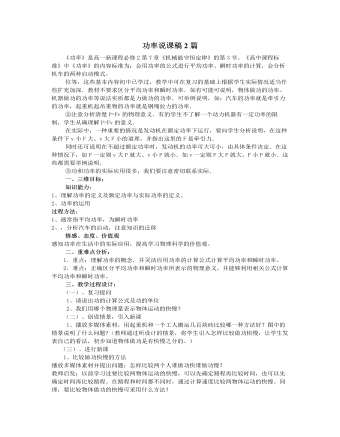
人教版新课标高中物理必修2功率说课稿2篇
(一)、复习提问1、请说出功的计算公式及功的单位2、我们用哪个物理量表示物体运动的快慢?(二)、创设情景,引入新课1、播放多媒体素材,用起重机和一个工人搬运几百块砖比较哪一种方法好?图中的情景说明了什么问题?(教师通过所设计的情景,将学生引入怎样比较做功快慢,让学生发表自己的看法,初步知道物体做功是有快慢之分的。)(三)、进行新课1、比较做功快慢的方法播放多媒体素材并提出问题:怎样比较两个人谁做功快谁做功慢?教师启发:以前学习过要比较两物体运动的快慢,可以先确定路程再比较时间,也可以先确定时间再比较路程。在路程和时间都不同时,通过计算速度比较两物体运动的快慢。同理,要比较物体做功的快慢可采用什么方法?